The Panel
Think of the panel as your phone system's control center - a visual workspace where you can drag, drop, and connect different pieces to build exactly what you need. Whether you're setting up a simple voicemail or creating a complex call center, everything happens right here in this intuitive interface.
For more simple setups, you can just setup a "user" and "contact method" from the main menu - no need to use modules.
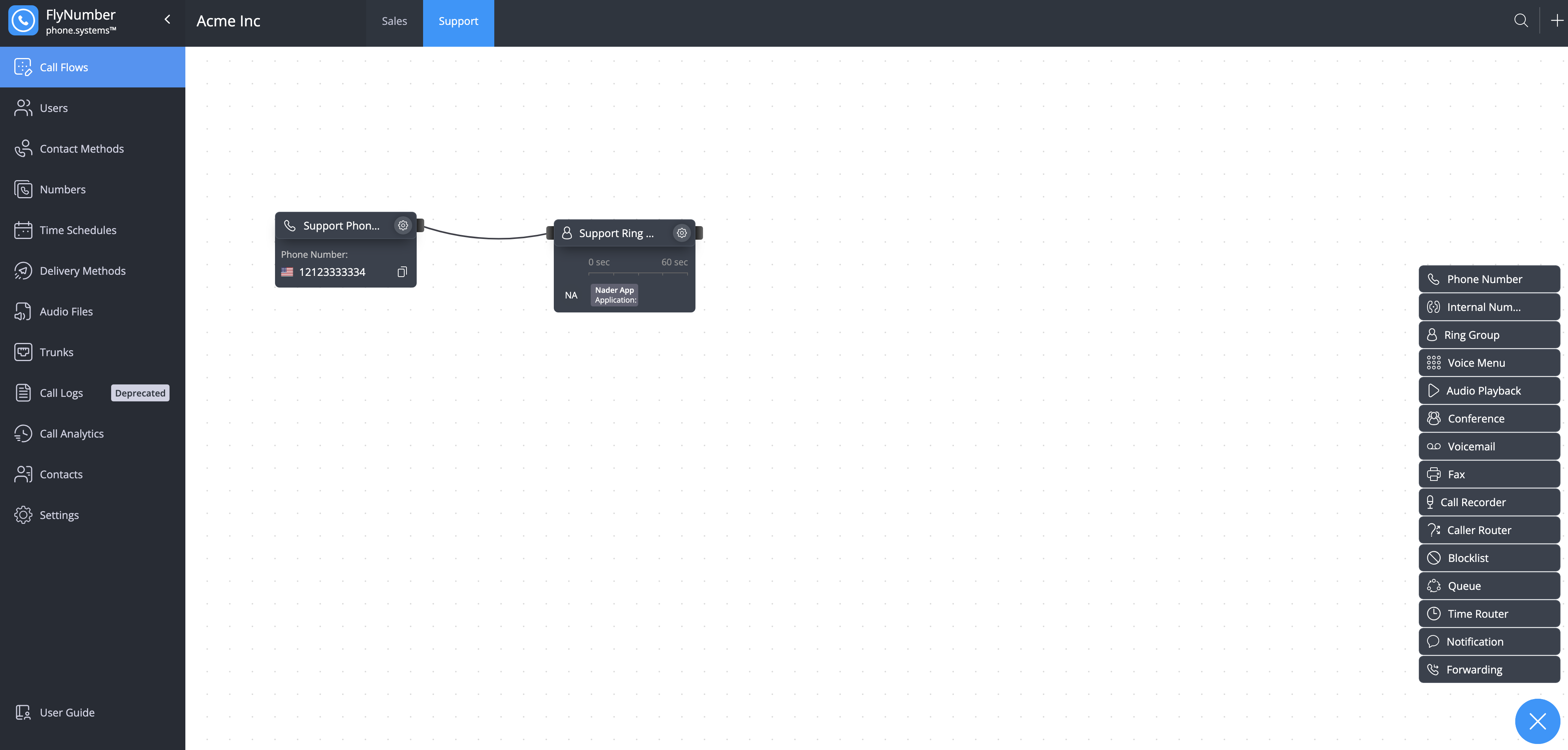
While the panel will load on a smartphone fine, we suggest using a desktop to configure your call logic.
Main Components
The phone system interface consists of several key components:
- Modules - Various building blocks that perform specific functions like voicemail, time routing, conferencing, etc
- Module Menu - Located on the right side, contains all available modules for building call flows
- Main Menu - Located on the left side, provides access to important system components like phone numbers, users, contacts, etc
- Call Flows - Areas where you can organize your phone system configurations based on departments or functions
- Workspace - The main area where you place modules and assemble call flows
- Workspace Tab Menu - Allows you to organize your workspace across multiple tabs
- Trash Bin - For removing modules from the workspace
- Cables - Used to connect modules together to define call flow logic
Main Menu
The Main Menu provides access to all core functions and settings:
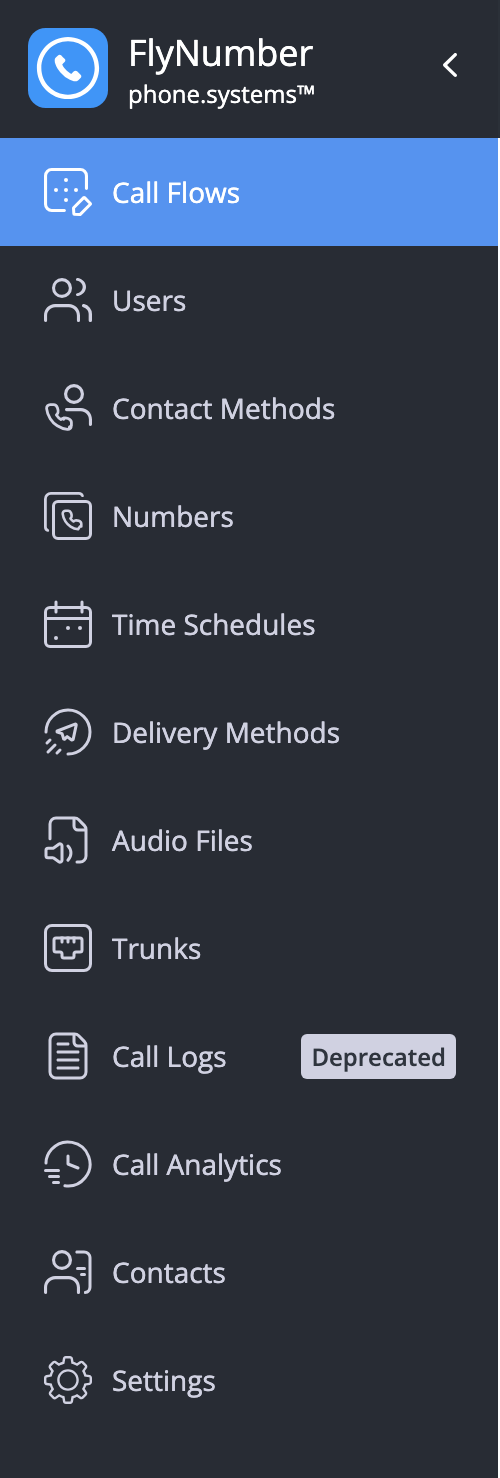
- Call Flows - Organize call routing based on departments or functions
- Users - Manage user accounts and app devices in the phone system interface
- Contact Methods - Configure SIP accounts, routing, and email settings
- Numbers - Manage phone numbers and internal extensions
- Time Schedules - Set up working hours for "Users"
- Delivery Methods - Configure delivery of voicemails and notifications via Email, Dropbox, FTP, SFTP, Google Drive, or OneDrive
- Audio Files - Manage audio recordings for greetings and music
- Settings - Access system-wide configurations and feature codes
Module Menu
The Module Menu contains all available modules for building call flows:

Available modules include:
- Phone Number
- Internal Number
- Ring Group
- Voice Menu
- Audio Playback
- Conference
- Voicemail
- Fax
- Call Recorder
- Caller Router
- Blocklist
- Queue
- Time Router
- Notification
- Forwarding
The Module Menu can be minimized by clicking the X icon in the bottom right corner. Click the + icon to expand it again.
Modules
Each module performs specific functions in your call flow. Modules have either one or two sockets:
- Left socket: Input for receiving calls
- Right socket: Output for sending calls to the next module
Module Configuration
When you place a module on the workspace, a configuration dialog opens automatically. You must:
- Complete all required fields
- Click Save to add the module to your call flow
Duplicating Modules
To save time when creating similar configurations, you can duplicate existing modules:
- MacOS
- Windows
Hold the Option key while dragging a module
Hold the Ctrl key while dragging a module
The new module will retain all settings from the original.
Some modules, like Phone Number and Internal Number, cannot be duplicated since they require unique numbers
Selecting Multiple Modules
To select and move multiple modules:
- MacOS
- Windows
- Hold Command to select individual modules
- Hold Shift to select a connected group of modules
- Hold Ctrl to select individual modules
- Hold Shift to select a connected group of modules
Selected modules will show a blue border and can be:
- Moved together on the workspace
- Moved to another tab
- Deleted using the Trash Bin
Workspace
The workspace is where you assemble your call flows. Here's how to use it effectively:
- Drag modules from the Module Menu onto the workspace
- Position them where needed
- Configure each module using the settings dialog that appears automatically
- Connect modules using cables to create the call flow logic
All required fields in the module configuration must be completed before saving the module to the workspace
You can reposition modules on the workspace at any time by dragging them to new locations.
Workspace Tab Menu
The Workspace Tab Menu helps organize complex phone systems across multiple pages. This feature is particularly useful when building systems for multi-branch businesses or complex call flows that need logical separation.
- Managing Tabs
- Moving Modules
- Connecting Across Tabs
To add a new tab:
- Click the + icon in the top right of the Workspace Tab Menu
- Enter a name for the new tab
- Click Save
To manage existing tabs:
- Hover over a tab to see the settings icon
- Click the settings icon to rename the tab
- Use the delete button to remove a tab (requires at least one other tab)
- Drag tabs horizontally to reorder them
Deleting a tab will remove all modules and configurations on that workspace page. Use caution when deleting tabs
You can move modules between different workspace tabs to organize your call flows better:
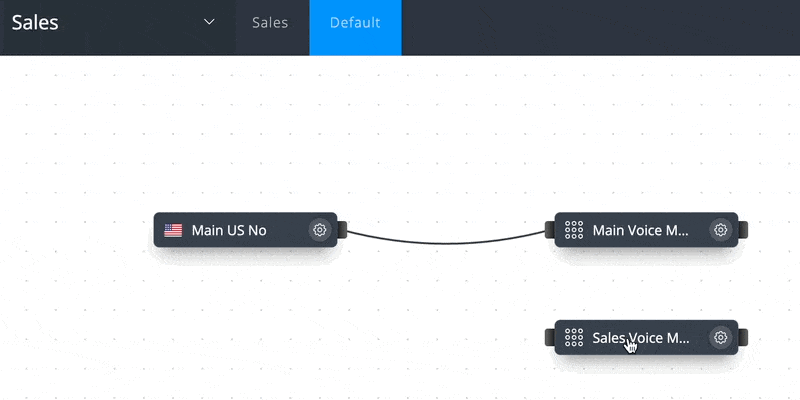
To move a module to a different tab:
- Drag the module over the destination tab
- Wait for the tab to activate (shown in blue)
- Continue dragging the module down into the workspace
- Release in the desired position
When moving a module that's connected to other modules, the connections will be maintained. A special icon will appear to indicate the connection spans across different tabs
You can connect modules that are on different workspace tabs:
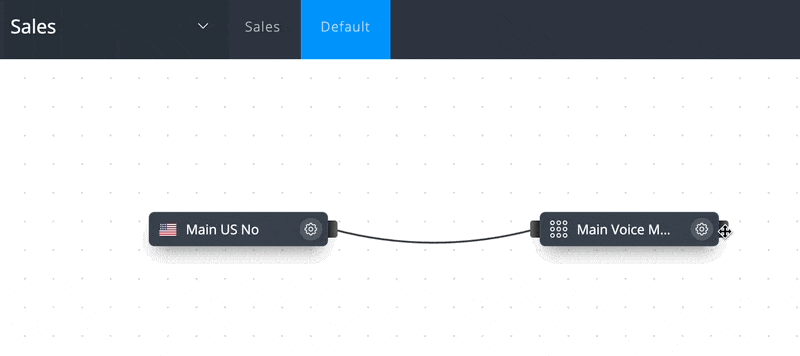
- Start dragging a cable from a module's output socket
- Drag it over the destination tab
- Wait for the tab to activate
- Continue dragging to the target module's input socket
- Release to create the connection
The connection between modules on different tabs will be shown with a special icon that you can click to quickly navigate between the connected tabs.
Instead of building everything on one tab and then moving modules around, it's often easier to:
- Create all needed workspace tabs first
- Build each section of your call flow on its appropriate tab
- Connect the sections together using cross-tab cables
Call Flows
Call Flows help you organize different aspects of your phone system. For example, you might create separate Call Flows for:
- Sales department
- Support team
- Billing inquiries
- General reception
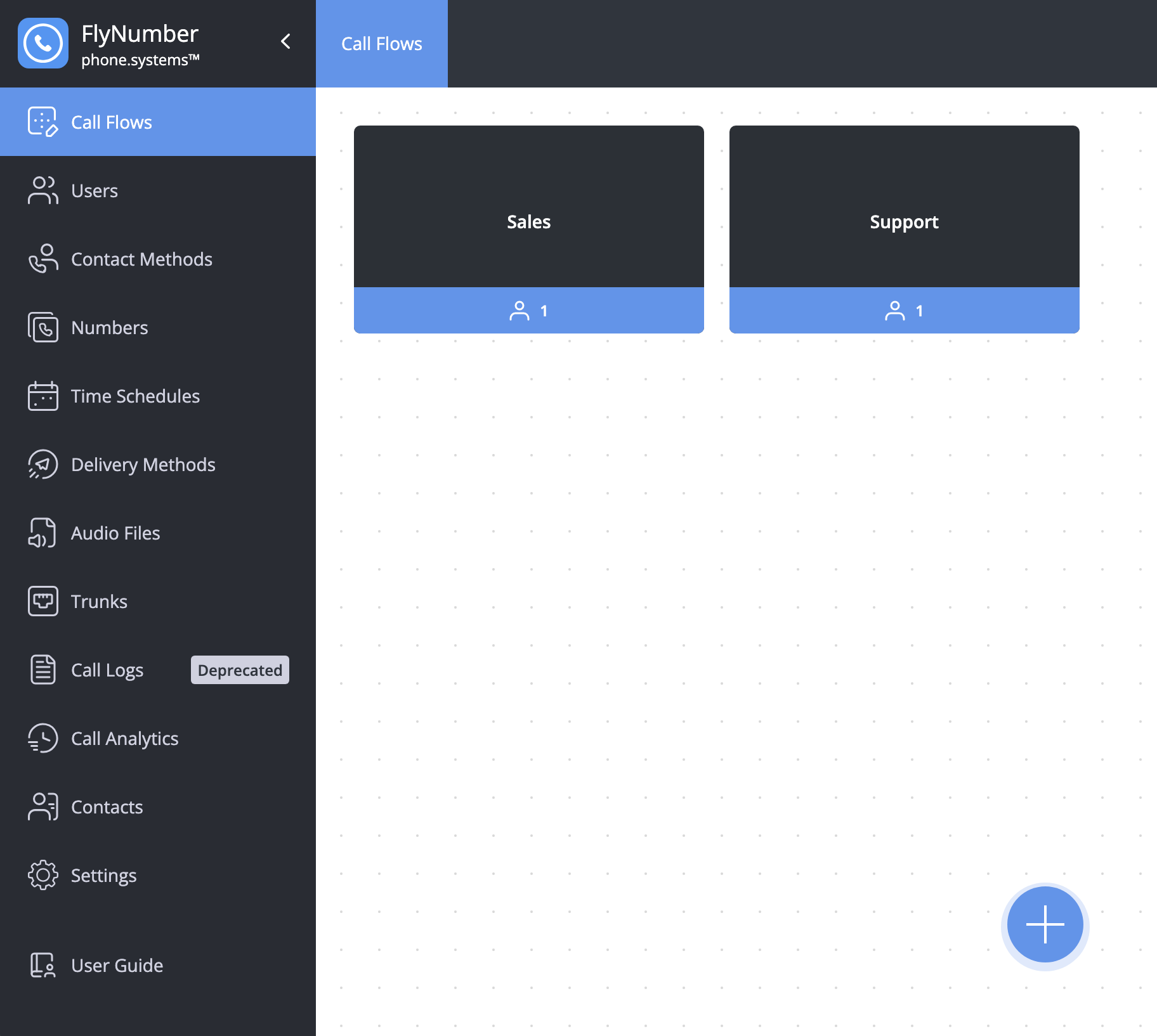
Creating a Call Flow
To create a new Call Flow:
- Click the + button in the bottom right
- Enter a name for the Call Flow
- Add users who will be part of this Call Flow
- Click Save
Managing Call Flows
You can quickly switch between Call Flows by clicking the Call Flow name at the top of the workspace.
To edit an existing Call Flow:
- Click the Actions button
- Select Edit
- Make your changes
- Click Save
To delete a Call Flow:
- Click the Actions button
- Select Delete
- Confirm the deletion
Once deleted, a Call Flow cannot be restored. All associated data and settings will be permanently lost
Cables
Cables create logical connections between modules to define call flows.
- Basic Connections
- Multiple Functions
- Yes/No Logic
- Removing Cables
To connect modules:
- Hover over the right socket of the source module
- Click and drag to create a cable
- Connect it to the left socket of the destination module

Some modules, like Voice Menu, can have multiple cables with different functions:
- Extension number routing
- Invalid extension handling
- Timeout handling
When connecting these cables, a configuration window appears to set the specific function. For example below, when adding modules after the voice menu, you'll be prompted for the digit(s) a user would need to press to get said module.
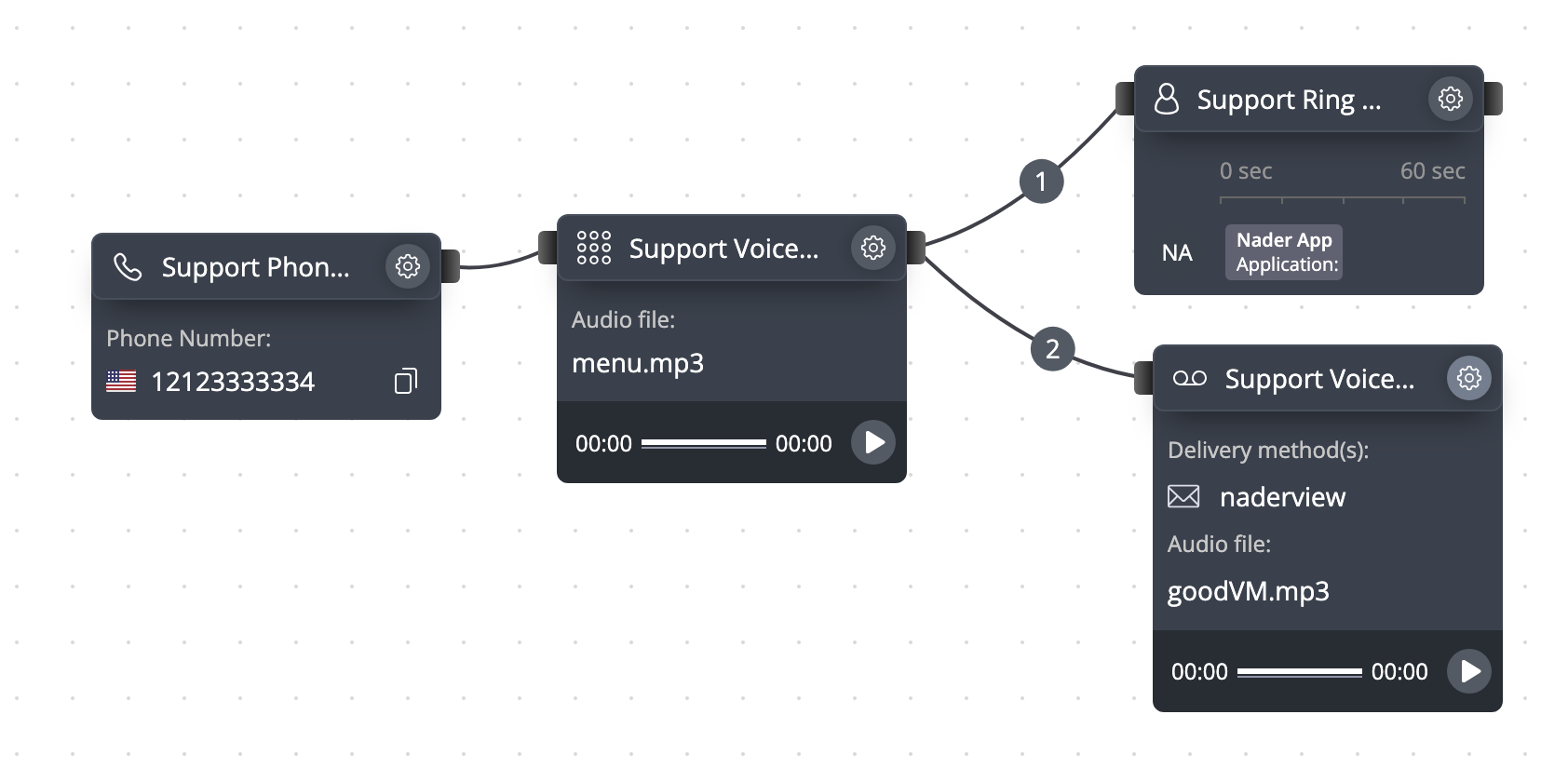
Modules like Time Router and Caller Router have two output sockets:
- Green socket (Yes): For successful condition matching
- Red socket (No): For condition matching failures

To remove a connection:

- Hover over the cable until the delete icon appears
- Click the delete icon
- Confirm the deletion in the popup dialog
When a module has no outgoing connection (no cable from its right socket), calls will end after that module's function is complete
Search
The search tool helps you find resources across your phone system:
- Click the magnifying glass icon in the Workspace tab menu
- Enter your search term
- Results will be grouped by resource type
For each search result, you can:
- Use the locate icon (🔍) to find the item in the workspace
- Use the settings icon (⚙️) to access the item's configuration
Trash Bin
The Trash Bin allows you to remove modules from the workspace:
- Drag a module toward the + or X icon in the bottom right corner
- The icon will change to a Trash Bin
- Drop the module on the Trash Bin to delete it
The Trash Bin does not have a recovery feature. Deleted items cannot be restored
You can also delete multiple selected modules by dragging them to the Trash Bin together